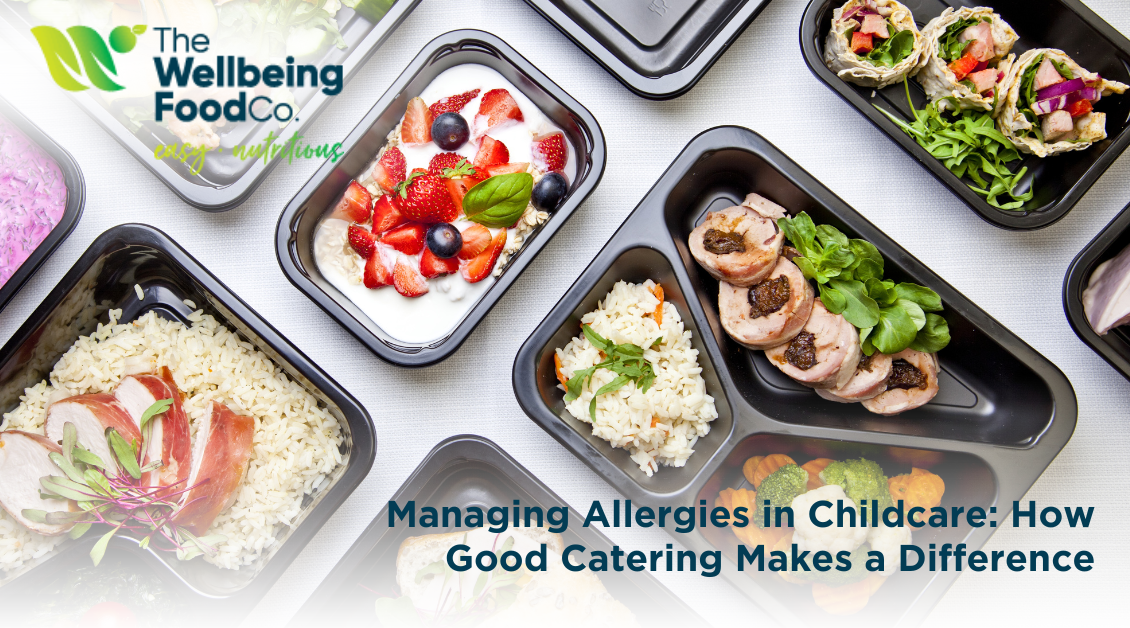Childcare catering is no longer just about providing food that fills bellies. In today’s landscape, it plays a critical role in safeguarding children with allergies, ensuring they are not only fed but also protected. The rise in childhood allergies means centres must go beyond just being “allergy aware” — they need partners who understand the full picture and can deliver meals that are nutritious, compliant and safe. Good catering isn’t a luxury anymore. It’s a lifeline.
The Growing Allergy Landscape in Australian Childcare
Allergies in children have skyrocketed over the past two decades in Australia. With more than 1 in 10 infants now affected by food allergies, childcare centres must treat allergy management as a foundational part of their operation. This includes everything from anaphylaxis risk protocols to menu design.
Unlike past generations, where allergies were rare and generally mild, many children today experience severe reactions to everyday foods like eggs, dairy, peanuts or soy. These aren’t just inconveniences — they’re potentially life-threatening issues. That’s why centres must align with caterers who not only understand these risks but have the systems and training to manage them.
Good catering partners help centres adapt to this changing environment. They avoid high-risk allergens in shared meals, label individual items with precision, and train staff on allergen cross-contamination. It’s no longer acceptable to say “we don’t serve nuts” and call it a day. True allergy-safe catering means personalised, careful, and regulated food delivery.
Why Allergy-Safe Catering is About More Than Just Labels
You might think slapping a “gluten-free” or “nut-free” label on a meal is enough. But in the world of allergy-safe childcare catering, this simply doesn’t cut it. Labels can be misleading, and without proper kitchen protocols, even the best intentions can end in disaster.
Children are vulnerable. A child with a dairy allergy, for example, might react to a meal that was prepared on a surface where cheese was sliced an hour ago. That’s why true catering partners in the childcare space go deeper. They implement:
- Allergen-specific production zones
- Colour-coded containers and utensils
- Dedicated staff training on allergy protocols
- Written compliance with the Australia New Zealand Food Standards Code
When these practices are in place, trust is built not only with childcare operators but also with parents. The catering provider becomes an extension of the centre’s commitment to safety.
Case Study: When Systems Save Lives
At a mid-sized childcare centre in Brisbane, a young boy named Luca was newly diagnosed with a soy allergy. His parents were overwhelmed, his educators nervous, and meal times became a point of daily anxiety.
Enter a catering provider with rigorous allergy systems in place. They immediately documented Luca’s allergy, updated digital meal profiles, and worked with the centre to implement a red-coded meal container for high-risk children.
Three weeks later, an unlabelled snack tray accidentally made its way to Luca’s table during an incursion day. But because his red-coded lunch stood out, and the staff were trained on “high alert” processes, they caught the error before he took a bite.
This wasn’t luck. It was systemised vigilance. And it proved the difference between a close call and a serious medical emergency.
Adapting to the Age-Specific Nutritional Guidelines
Managing allergies doesn’t happen in a vacuum. Centres must also meet strict government guidelines around nutrition — and those guidelines vary by age.
Infants (0-1), toddlers (1-3) and preschoolers (4-8) each require tailored meals with age-appropriate textures, nutrients and portion sizes. Allergy-friendly meals still need to meet daily intake targets for calcium, iron, and protein.
A quality childcare caterer doesn’t just remove allergens — they replace them with equivalent nutritional options. For instance:
- Replacing dairy with calcium-fortified oat or rice milk
- Using chickpea purées or lentil dishes as egg-free protein sources
- Swapping wheat-based products with iron-rich whole grain gluten-free options
These substitutions maintain meal integrity without compromising the child’s development needs.
Navigating Multiple Allergies and Intolerances in One Group
It’s common for centres to have multiple children with vastly different dietary restrictions. One might be coeliac, another allergic to nuts, and another lactose intolerant. Managing this level of complexity internally is overwhelming.
That’s where structured catering plays its biggest role. Customised meals, clearly labelled, arrive in sealed containers. Each meal aligns with the child’s dietary plan, minimising risks and giving educators confidence.
Rather than attempting to adapt bulk meals on-site — which often leads to errors — centres can lean on their caterers for structured support.
In fact, forward-thinking caterers go a step further, offering:
- Digital meal management systems
- Weekly allergy audits
- Direct parent communication tools
These tools help eliminate confusion, reduce paperwork and keep everyone aligned.
The Importance of Allergen Education and Training
No allergy-safe meal system can succeed if the people serving those meals are unaware of the risks. That’s why strong catering partnerships include educator training as part of their service.
Topics covered usually include:
- Recognising early signs of allergic reactions
- Emergency response protocols
- Managing food sharing risks at meal time
- Understanding ingredient terminology
Training is not a once-off activity. It must be refreshed regularly and adapted as guidelines change. When educators understand the “why” behind allergy processes, compliance improves.
Catering teams can also assist in building allergy communication plans — from signage in food areas to allergy alert wristbands and daily allergy checklists.
Helping Centres Build Parent Confidence
Parents of children with allergies often experience anxiety when leaving their kids in care. They’ve spent years reading food labels, prepping meals, and educating family members — handing that over to someone else can feel daunting.
High-quality catering programs build parent trust in three main ways:
- Transparency: Full menus, ingredients lists and preparation protocols are available on request.
- Personalisation: Individual child needs are documented and visible to the team.
- Communication: Open dialogue with parents helps ensure no assumptions are made about their child’s condition.
When centres can point to a robust, well-documented catering system, parents breathe easier. It’s not just about ticking boxes — it’s about reassurance.
Catering as a Tool to Grow Occupancy
This might surprise some, but allergy-safe catering can actually boost a centre’s enrolments. Parents of children with allergies often struggle to find providers they trust. When a centre clearly demonstrates their allergy-safe credentials, it becomes a key differentiator.
Promoting your centre’s allergy-safe catering solution (with parental consent and privacy safeguards) can help:
- Build reputation through word-of-mouth
- Increase your appeal to health-conscious families
- Open doors to partnerships with medical practitioners and support groups
Rather than viewing food allergies as a burden, centres can treat them as an opportunity to lead the pack.
Why Frozen Meals Can Still Be Safe and Nutritious
Some providers worry that offering frozen meals may be seen as a compromise on nutrition or allergy safety. But the truth is: frozen doesn’t mean inferior. In fact, freezing can preserve nutrients, improve shelf stability, and reduce the risk of cross-contamination.
Frozen meals, when prepared in a controlled commercial kitchen, can be more consistent than ad hoc daily meal prep on-site. They’re also easier to portion, label, and track.
The key is ensuring frozen meals meet the same high standards as fresh meals, including:
- Transparent ingredient sourcing
- Batch tracking
- Allergen-free verification
Used properly, frozen catering expands flexibility while maintaining safety and quality.
Benefits of Frozen Meals vs Unfrozen Ready to Eat Meals
- Freezing is an effective and reliable preservation technique. It can result in the use of less added preservatives in food.
- Freezing of foods maintains food flavour, freshness and nutrient retention (Pai JS, 2003). Unfrozen meals may experience water drop (resulting in a soupy texture) and nutrient loss due to physical degradation.
- Freezing significantly slows or stops the growth of almost all microorganisms (bacteria, mould) and enzyme activity which can cause food spoilage or foodborne illness (James C etc al, 2024). Psychrophiles, or cold-loving bacteria, can still cause spoilage in chilled food as they are most active around 0⁰C (Pai JS, 2003)
- Freezing contributes to less food wastage due to longer shelf life and less susceptibility to spoilage.
- Freezing increases confidence in food safety, especially when serving vulnerable populations e.g. children.
- Advances in quick freezing techniques have resulted in better food quality.
FAQs
1) What are the most common food allergies in childcare?
In Australian childcare centres, the most frequently encountered allergies include dairy, eggs, peanuts, tree nuts, soy, wheat and seafood. Among these, dairy and egg allergies are particularly common in infants and toddlers, while nut allergies often persist into later childhood. It’s important to note that some children have multiple allergies, which increases the complexity of meal planning and delivery.
What makes these allergens challenging is their prevalence in many processed foods and their potential to cause severe reactions. Caterers must therefore not only avoid obvious sources but also understand hidden ingredients — for example, egg powder in baked goods or whey protein in sauces. Clear labelling and proper cross-contamination training are crucial to preventing accidental exposure in childcare settings.
2) How can childcare centres ensure allergy-safe meal delivery?
Allergy-safe meal delivery in childcare involves a multi-layered approach:
- Documentation: Each child’s allergy profile must be accurately recorded and updated.
- Custom Labelling: Meals need clear, tamper-proof labels with allergen information.
- Separation: Meals for allergic children must be prepared and packed separately.
- Education: Staff must be trained on recognising symptoms and administering EpiPens if needed.
Partnering with a professional catering service that specialises in allergy-safe systems significantly improves reliability. They bring structure, consistency and oversight to what is otherwise a high-risk, high-stakes daily task.
3) Are fresh meals always better than frozen for allergy management?
Not necessarily. While fresh meals can be appealing, frozen meals have advantages when it comes to consistency and allergen control. They allow for:
- Centralised production in controlled environments
- Pre-verified ingredient safety
- Longer shelf life without relying on preservatives
As long as frozen meals are prepared by experts, flash frozen quickly, and reheated properly, they can match fresh meals in nutrition and flavour. What matters more than temperature is the system behind the meal.
4) What should parents ask their childcare provider about catering?
Parents of children with allergies should ask:
- Who prepares the meals and where?
- How are allergies documented and communicated to the catering team?
- Are meals sealed and individually labelled?
- What training do educators receive on allergy management?
They should also request a sample menu and ask about substitution practices. Transparency is key. If a provider struggles to answer these questions, it may be a red flag about their allergy-readiness.
5) Can allergy-safe catering help children with fussy eating habits?
Absolutely. Many fussy eaters are actually reacting to food intolerances or sensory issues, which can mimic or mask true allergies. Allergy-safe catering often includes:
- Textural variety
- Mild flavour profiles
- Familiar ingredients prepared in creative ways
By creating meals that are not only safe but also appealing, caterers can help children build positive food associations. Gradual exposure to new, safe options can increase acceptance over time.
Food Safety, Allergy Awareness and the Power of Good Partnerships
Managing allergies in childcare is no small feat. But with the right catering partner, it becomes manageable — even empowering. Good catering supports child development, staff confidence, and parent trust. It transforms a logistical headache into a strength.
Please call us at the Wellbeing Food Co today on (07) 3062 9268 or leave a message.


